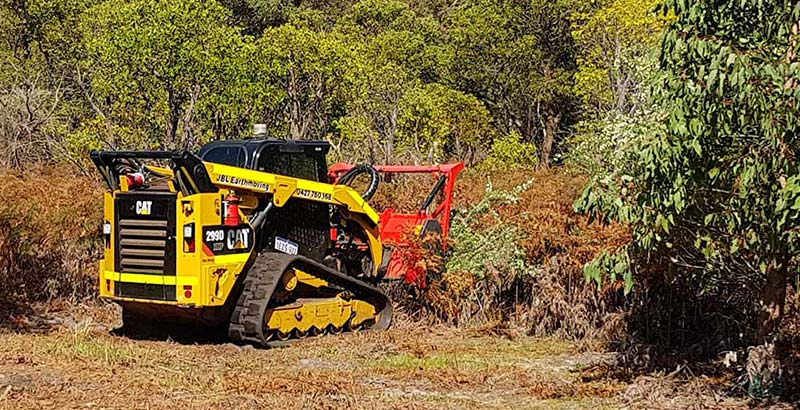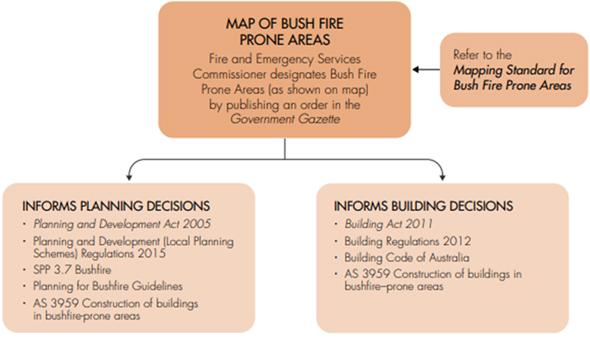Fire or life threatening emergencies: 000
Emergency Information: 13 3337
SES Emergency Assistance: 132 500

The Map of Bushfire Prone Areas identifies land in Western Australia that has the potential to be impacted by bushfires. This land is designated by the Fire and Emergency Services Commissioner.
Additional planning and building requirements may apply to new proposals within a bushfire prone area. A further assessment of bushfire risk may also be required to ensure future developments in bushfire prone areas are safer.
The requirements are described in State Planning Policy 3.7: Bushfire (SPP 3.7) and the Planning for Bushfire Guidelines (the Guidelines). You can find these documents at wa.gov.au.
Additional planning and building requirements may apply to development within designated Bushfire Prone Areas, in accordance with Schedule 2 Part 10A of the Planning and Development (Local Planning Schemes) Regulations 2015, SPP 3.7, the Guidelines, and the Building Code of Australia.
If you are the proponent, you’ll be responsible for ensuring that the proposal complies with the relevant planning policies and building regulations.

Tip: If the map appears blank, you may need to clear the cache in your browser. Alternatively, check for mapping outages here.
The Map of Bushfire Prone Areas is reviewed regularly to better represent bushfire risk across Western Australia.
The latest version of the Map was designated under section 18P of the Fire and Emergency Services Act 1998 and came into effect on 13 December 2025.
A four month transition period will apply for newly designated areas on the Map.
Please contact your local government if you have information to contribute to the next review of the Map.

DFES plays an important role providing technical bushfire related advice to inform and guide decision-making on strategic planning proposals, and subdivision and development applications for land within a designated bushfire prone area.
The Land Use Planning team also provide evidence for the State Administrative Tribunal (SAT) proceedings on bushfire risk, together with its consequences for planning decisions; and act as a referral agency when there is Unexploded Ordnance (UXO) contamination.
DFES encourages developers, consultants and bushfire planning practitioners to discuss bushfire risk avoidance/mitigation with the decision maker early in the planning process.
DFES provides advice on potential hazards of changing land use or developing unexploded ordnance (UXO) affected sites and makes recommendations where a UXO Risk Assessment (or similar) of land is appropriate to identify and address UXO risk. DFES does not have technical knowledge in UXO management, and its advice is mostly based on the information available from the Department of Defence.

To send a referral, or to discuss a land use planning proposal, please contact the Land Use Planning team:
Email: advice@dfes.wa.gov.au
Please note that all referrals by decision makers requesting DFES advice, are to be accompanied by a DFES Referral Checklist.
WA Statutory and Policy Framework (Source: Planning for Bushfire Guidelines, DPLH, November 2024)

Strategic planning proposals and subdivision and development applications on land within a bushfire prone area are to address bushfire risk in accordance with State Planning Policy 3.7 Bushfire and associated Planning for Bushfire Guidelines.
The Statewide Map of Bush Fire Prone Areas is available on our website.
This map is prepared by DFES’ Office of Bushfire Risk Management (OBRM) in accordance with the Mapping Standard for Bush Fire Prone Areas. OBRM is responsible for preparing, reviewing, maintaining and administering the map.
Where a planning proposal or development is on land designated as bushfire prone on the Map of Bush Fire Prone Areas, and:
it may trigger the application of State Planning Policy 3.7 Bushfire (SPP 3.7) and associated Planning for Bushfire Guidelines (Guidelines).
We recommend you contact the relevant decision maker for your proposal early in the planning process, to discuss whether it triggers the application of SPP 3.7 and the Guidelines, and how bushfire risk can be avoided or mitigated.
The following instances will usually trigger a referral to us for strategic planning proposals and subdivision and development applications:
A Bushfire Management Plan (BMP) contains an assessment of the bushfire hazard and risk using the bushfire protection criteria requirements contained in the Planning for Bushfire Guidelines, and its potential to affect people, property and infrastructure.
The BMP also sets out the risk management strategies for the life of the development.
The BMP is a key consideration whether a strategic planning proposal, subdivision or development application should be approved.
Further information relating to BMP, including the Bushfire Management Plan (BMP) Manual and examples of BMPs are available on the ‘Bushfire’ page of the Department of Planning, Lands and Heritage website.
DFES’ Land Use Planning team can provide broad preliminary advice to stakeholders and the public. However, it is recommended that you seek advice from the relevant decision maker.
Further information is available on the ‘Bushfire’ page of the Department of Planning, Lands and Heritage website.
An Unexploded Ordnance (UXO) is any type of military ammunition or explosive ordnance that has failed to function as intended and is generally the result of military training activities. Learn more.
The location of UXO affected areas within Western Australia is available on the Department of Defence website.
If the UXO category is ‘Substantial’:
The area has a confirmed history of military activities that often results in residual hazards. There is a history of numerous UXO finds or heavy residual evidence such as fragmentation.
Department of Defence (DoD) Advice: ‘Any development, land usage re-zoning proposals, or other significant changes in proposed activities should only proceed once an appropriate UXO Risk Assessment has been conducted by a suitable specialist. Mitigations should be implemented to address the risks identified. Mitigations can include one or more of the following:
If the UXO category is ‘Slight’:
The area has a confirmed history of military activities that often results in numerous residual hazards, but where confirmed UXO affected areas cannot be defined.
DoD Advice: ‘Land use may continue without further UXO investigation or remediation, however Defence recommends obtaining specialist advice and undertaking a detailed UXO risk assessment and developing a UXO management plan. Defence also recommends that any development, land usage re-zoning proposals or other significant changes in proposed activities are preceded by an appropriate UXO risk assessment. Ongoing activities and the possibility of encountering munitions should be adequately addressed in activity plans (e.g. construction site safety management plans).’
There is generally a lesser risk of the presence of UXO than on sites classified as Substantial.
If the UXO category is ‘Remote’:
The area was used for military purposes; however, the activity is of a nature that makes it unlikely that UXO would exist. Alternatively, areas that have been subject to Defence validated UXO remediation may also be categorised as remote.
DoD Advice: ‘All land usage and development, within these areas, may continue without further UXO investigation or remediation. If at any time UXO or related material is identified, consideration should be given to seeking specialist advice.’
If the UXO category is ‘Other’:
The area was used for military training, however no confirmation that it was used for live firing. UXO or explosive ordnance fragments/components have not been recovered from the site.
DoD Advice: ‘These sites have been included for general information purposes only. Defence makes no recommendations in regard to this category.’
If the UXO category is ‘Information’:
The area was used for routine military activity, however, was of a type not associated with producing UXO.
DoD Advice: ‘These sites have been included for general information purposes only. Defence makes no recommendations in regard to this category.’
If the UXO category is ‘Sea Dumping’:
The area has been used for historical sea-dumping of waste material that may include explosive ordnance. These sites are generally marked on charts and published in Notice to Mariners along with appropriate advice.
DoD Advice: ‘There are no restrictions to surface maritime activities in these areas. Any activity that will disturb the seabed such as anchoring, trawling and dredging are prohibited in these areas.’
Further information relating to UXO is available on the Department of Defence website.
The Department of Defence has established the Defence Infrastructure Panel – Environment, Heritage and Estate Engineering Services, which includes suitably qualified and specialist consultants/contractors that conduct UXO related work. A list of consultants/contractors is available on their website.
DFES does not undertake UXO related works, such as assessments.
This refers to areas that have a confirmed history of military activities that often results in numerous UXO finds or heavy residual evidence such as fragmentation. These areas may have been exposed to extensive and repeated surface disturbance which can be deemed to be clear of UXO. However, the sub-surface of these areas is highly likely to contain UXO. It is estimated from the previous military activities and recovery rate of UXO in these areas that many UXO remain undisturbed. This is why a UXO Risk Assessment should be undertaken before any earthworks or change of land use commences. The assessment will determine the mitigations required to address the risks identified.
For map and dataset queries, contact us at the Office of Bushfire Risk Management. To enquire about a referral or UXO contamination, contact the Land Use Planning team.